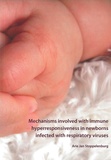Mechanisms involved with immune hyperresponsiveness in newborns infected with respiratory viruses
Summary
Acute infection with respiratory syncytial virus (RSV) generally occurs during the first year of life. Approximately 1% of all infants is hospitalized for RSV bronchiolitis, of which 10% requires intensive care. RSV bronchiolitis is hallmarked by exaggerated mucus production and neutrophil infiltration to the lower airways, which peaks prior to the adaptive immune response.
The infant vulnerability to viral infection has long been attributed to reduced employment of antiviral Th1 activation leading to a preferred activation of Th2 responses. Although Th2 cytokines are certainly involved in RSV disease, they do not suffice to explain all aspects of RSV bronchiolitis. Furthermore neither the timing of RSV pathology, nor the marked correlation of innate immune gene variants to RSV bronchiolitis are sufficiently explained by the model of Th2-driven immunopathology. Understanding the immunopathogenesis of RSV bronchiolitis could open avenues for novel therapeutic strategies.
IL-17 in RSV bronchiolitis
In the balance of T-helper cell polarizations, decreased Th1 responses as they occur in infants allow for elevated Th17 responses. Indeed, RSV infection in infants associates with elevated IL-17 and accumulation of CD161+ T cells in patient lungs, as well as locally elevated concentrations of Th17 polarizing cytokines. Circulating Th17 cells are present in one-month-old RSV patients, but absent in healthy infants of the same age. IL-17 thus may contribute to RSV airway immunopathology.
Th17 responses were previously reported to facilitate neutrophil migration. As lung neutrophilia in RSV precedes adaptive immunity, we asked whether IL-17 from an innate source causes neutrophil infiltration to RSV infected lungs. Local IL-17 concentrations in RSV patients early after hospitalization correlate with subsequent lung neutrophilia. An IL-17 blocking antibody prevented day 2 post-infection lung neutrophilia in RSV infected mice. We thus show that early local IL-17 production in the airways facilitates neutrophil recruitment to RSV-infected infant lungs.
Vitamin D and RSV immune activation
Vitamin D deficiency and a well-described polymorphism in the vitamin D receptor (VDR), FokI, are important risk factors RSV bronchiolitis. We investigated the role of vitamin D mediated regulation by studying the FokI VDR variant.
While normal VDR regulates NF-κB and STAT1 responses. FokI VDR fails to regulate both RSV-induced STAT1 phosphorylation and the expression of its downstream targets IRF1 and IRF7. The poor capacity of vitamin D to regulate IRF1 in FokI VDR expressing cells was recapitulated using blood samples from normal and FokI VDR genotyped healthy donors. Our data suggests that strong activation of innate STAT1 responses may be detrimental in RSV disease, but by what means is unclear. It also indicates that vitamin D supplementation may not protect against RSV disease in all individuals.
As a common concept, reduced regulation of immune activation seems to cause immunopathology in RSV disease. Infants are particularly vulnerable to excessive deployment of Th2/Th17 responses. Likewise, impaired regulating capacity of anti-viral responses by VDR may enhance RSV pathology. Targeted immune regulation, notably of STAT1 and IL-17, may be an appropriate approach for novel RSV therapies.
